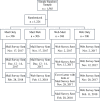The impact of survey mode on the response rate in a survey of the factors that influence Minnesota physicians' disclosure practices
- PMID: 30940087
- PMCID: PMC6444519
- DOI: 10.1186/s12874-019-0719-7
The impact of survey mode on the response rate in a survey of the factors that influence Minnesota physicians' disclosure practices
Abstract
Background: There is evidence that the physician response rate is declining. In response to this, methods for increasing the physician response rate are currently being explored. This paper examines the response rate and extent of non-response bias in a mixed-mode study of Minnesota physicians.
Methods: This mode experiment was embedded in a survey study on the factors that influence physicians' willingness to disclose medical errors and adverse events to patients and their families. Physicians were randomly selected from a list of licensed physicians obtained from the Minnesota Board of Medical Practice. Afterwards, they were randomly assigned to either a single-mode (mail-only or web-only) or mixed-mode (web-mail or mail-web) design. Differences in response rate and nonresponse bias were assessed using Fischer's Exact Test.
Results: The overall response rate was 18.60%. There were no statistically significant differences in the response rate across modes (p - value = 0.410). The non-response analysis indicates that responders and non-responders did not differ with respect to speciality or practice location.
Conclusions: The mode of administration did not affect the physician response rate.
Keywords: Mixed-mode; Non-response bias; Physicians; Response rate.
Conflict of interest statement
Ethics approval and consent to participate
Informed consent was implied if physicians completed and returned the survey. Written and verbal consent was not documented or directly obtained from participating physicians. This study was approved by the Institutional Review Board at the University of Minnesota, Twin Cities.
Consent for publication
Not applicable.
Competing interests
The authors declare that they have no competing interests.
Publisher’s Note
Springer Nature remains neutral with regard to jurisdictional claims in published maps and institutional affiliations.
References
-
- Cook JV, Dickinson HO, Eccles MP. Response rates in postal surveys of healthcare professionals between 1996 and 2005: an observational study. BMC HealthServ Res 2009;9(160). Available from https://doi.org/10.1186/1472-6963-9-160. - PMC - PubMed
-
- Cho YI, Johnson TP, VanGeest JB. Enhancing surveys of health care professionals: a meta-analysis of techniques to improve response. Eval Health Prof 2013;36(3):382–407. Available from 10.1177/0163278713496425. - PubMed
-
- McLeod CC, Klabunde CN, Willis GB, Stark D. Health care provider surveys in the United States, 2000-2010: a review. Eval Health Prof 2013;36(1):106–126. Available from 10.1177/0163278712474001 - PubMed
-
- Kellerman SE, Herold J. Physicians response to surveys. A review of the literature. Am J Prev Med 2001;20(1):61–67. Available from 10.1016/S0749-3797(00)00258-0 - PubMed
Publication types
MeSH terms
LinkOut - more resources
Full Text Sources


